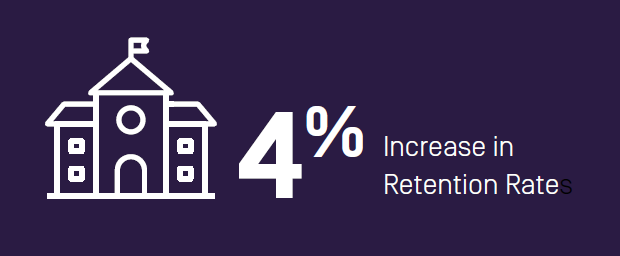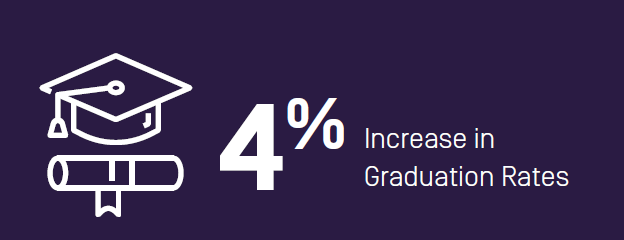Students start their journey in higher education with high hopes, but for many, unexpected difficulties can make degree completion difficult.
In Fall 2020, the overall college retention rate in the United States fell by its largest percentage since reporting began. The pandemic has made it difficult to attract new students as well. From 2019 to 2021, undergraduate enrollment declined by nearly 8%, and community college enrollment dropped 15%, according to research from the National Student Clearing House. This decline in retention and enrollment shows that the same old approaches to education aren’t working anymore. It’s time for colleges and universities to reevaluate their methods.


Students attempting to complete a certificate or a degree program are faced with many challenges.
1. Financial Burdens
A college education requires a significant investment. Many students must take out loans to pay for their education, leading them to worry about the future cost of this debt and how they will support themselves or their families during enrollment. Students’ ability to afford tuition, textbooks, and other educational expenses can impact an institution’s enrollment and retention rate.
2. Academic Challenges
College courses can be rigorous and demanding. After a few weeks of classes, some students realize that their earlier education did not prepare them for the new curriculum. Others have a gap in their education that leaves them without the necessary foundation for further studies. Taking multiple remedial courses or retaking classes to improve grades adds to the cost.
3. Balancing Commitments
Adult students and those studying at community colleges often have full-time jobs, children, families, or other responsibilities. Traditional college students often participate in internships, student councils, clubs, and extracurricular activities like intercollegiate athletics. All students are responsible for managing their time, mental health, and physical energy. Striking the balance between their many commitments can be
overwhelming, and the students who struggle to prioritize may leave school altogether.
4. Mental Health
With so many stressors to manage, many students experience anxiety. According to a recent survey, 47% of college students reported clinically significant depression and anxiety symptoms. Another 66% felt isolated from others regularly, a significant factor in developing negative mental health symptoms.
Increasing engagement and a sense of belonging can positively impact student mental health. Students may also need additional resources like counseling, coaching, and guidance in school success.
5. Student Assistance Resources
Many institutions offer some level of student assistance, but if students are unaware of the resources available to them or don’t use them, they are missing out on the help your institution can provide. Deeper issues may go unresolved, leading to attrition. Writing centers, academic tutors, guidance counseling, career success conferences, and faculty all contribute to student success.
Keeping students engaged and on track requires innovative solutions. Consider these approaches to reducing the challenges of student retention:
Proactive intervention can significantly change the story for a potential dropout.
With the insights we uncover in student data, institutions can intervene and provide personalized support before it’s too late. Predictive analytics help identify students in need of assistance and the obstacles standing in the way of their success.
Student data such as test scores, engagement, and socioeconomic and demographic factors can help identify each student’s risk levels and pinpoint when intervention is necessary to ensure success.
Let’s say there is a student who suddenly stopped attending classes. Using Watermark’s student success solution, professors and staff could easily note the student’s absences, which are compiled into that person’s student risk data. Despite the student’s attendance record, the system shows that they are still completing their assignments on time.
The absences alone may not raise a flag if assignments are still being completed. However, a wider risk analysis would reveal that some obstacle still stands in the way of the student’s ability to attend classes. Catching this detail early on helps institutions provide support before the student’s grades suffer, paving the way for the student to reach their fullest potential.
Collecting student data and utilizing predictive analytics helps institutions understand which students are at risk of attrition so advisors and success coaches know exactly where to provide proactive support. By analyzing data, you have the ability to read between the lines of each student. This lets you see the pathway of student performance, and if the student veers off course, you can intervene before it is too late.
Proactive intervention is a powerful factor toward increasing retention and student success. A study by Noel-Levitz found that student satisfaction and retention is heavily dependent on an advisor’s ability to demonstrate knowledge and concern.
| Data allows advisors to demonstrate knowledge and concern before students abandon their higher education journey. Colorado State University, for instance, made the decision to collect student data for proactive intervention. |  |
| As a result, the university improved its retention rates from 82% to 86% and improved graduation rates from 62% to 66%. |  |
It is important to note that clear communication across all campus departments and systems is crucial for gaining a full understanding of your students’ needs. Watermark’s AI-powered student success software can tell you the whole story now and give you a look at what’s ahead. Success coaches get automatic insights into which students need their support the most, and the solution places students into risk categories to help advisors prioritize their outreach.
In the fall of 2017, HCC was preparing for their 10-year reaffirmation with the Southern Association of Colleges and Schools Commission on Colleges (SACSCOC). As a requirement of reaffirmation, a college must develop a plan — called a quality enhancement plan (QEP) — to identify key issues and focus on solutions that support student learning. Haywood’s leadership team, along with other campus stakeholders, identified advising as their key issue.
To support HCC’s goals for an improved student advising process, decision-makers chose Watermark Student Success & Engagement (SS&E). “The price was doable for our small institution, and the customer service was incomparable,” Dr. Coleman says. Plus, the ease of use, customization, and product features like internal note-taking all worked together to create the best solution for their team.
As part of the plan, HCC also introduced success coaches who used Watermark tools such as notes, alerts, tags, filters, reports, and predictive analytics to help proactively advise students. With this technology-enabled success coaching, staff could intervene before bumps in the road became roadblocks. Behaviors like missing class for several days, being out sick, or falling behind in a course are all examples of alerts that success coaches can manage to keep track of student performance.
“Aligning people, process, and technology to achieve excellence in advising was critical for our QEP,” says Dr. Coleman. Through Watermark, the college hoped to streamline the advising process, improve student performance, and create a better experience on campus.
HCC has experienced a complete transformation in their approach to student engagement. “We’ve been able to get more purposeful with our attention, which has been a huge success for us,” says Dr. Coleman.
“I think that’s one of the great things about our usage of Watermark Student Success & Engagement over the past five years — realizing the potential it has and how we can use it to solve problems we didn’t even know existed.”
It’s time for institutions to rewrite the story of student success. Improving student retention is an effort consisting of several components working together. Data leads to information which leads to a better understanding of where students have been and where they are headed. Watermark’s solutions help faculty and staff see the needs of students, the challenges they are facing, and how best to help them on their academic journey.
With advanced, intuitive reporting, easy attendance tracking, early alerts, and other essential features, Watermark Student Success & Engagement makes it simple for student success coaches, advisors, faculty, and staff to quickly identify those students who need attention and determine the right course of action.
To learn more, visit https://www.watermarkinsights.com/solutions/student-success/

See how our tools are helping clients right now, get in-depth information on topics that matter, and stay up-to-date on trends in higher ed.